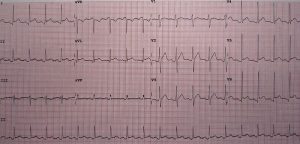Paracetamol overdose
Introduction Paracetamol (aka acetaminophen) is a widely used over the counter analgesic medication. In its recommended dose it is safe and effective. However, it also has the potential to cause…
Introduction Paracetamol (aka acetaminophen) is a widely used over the counter analgesic medication. In its recommended dose it is safe and effective. However, it also has the potential to cause…

Introduction Pericarditis is a common cause of chest pain, and may mimic the signs and symptoms of myocardial infarction. It is a result of inflammation of the pericardium. The two most…
This article describes adult respiratory tract infection. For more information, please see paediatric respiratory infections Introduction Pneumonia is a common lower respiratory tract infection, characterised by inflammation of the lung…
Introduction A pneumothorax is an abnormal collection of air in the pleural space - between the lung and the chest wall. They can be: Primary – no underlying lung disease. Secondary…
Postural Hypotension is a symptom, not a condition. This is colloquially known as a ‘head rush’ or ‘dizzy spell’, and is unsteadiness or LOC on standing from lying in those…
The Basics 98% is intracellular Serum range 3.5 – 5 mmol/L K+ and H+ tend to vary together Most body secretion is in urine – from distal tubules Shifts K+…

Introduction Pulmonary Embolism (also known as pulmonary embolus) is most commonly a complication of venous thromboembolism (VTE) from another source - e.g. a clot in the legs or pelvis (a DVT) that…
Introduction Pulse Oximetry is a way of measuring the oxygen level in the blood. It is a measure of oxygenation but not a measure of ventilation Oxygenation – the ability…
Introduction This is also sometimes called fever of unknown origin (FUO) It is strictly defined as: Temperature greater than 38.3’ Duration of longer than 3 weeks During which time there…